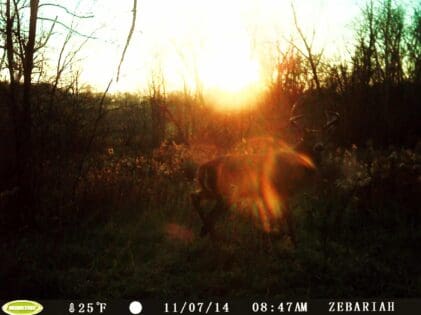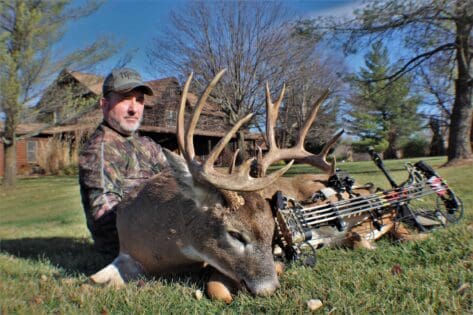Connecting the Dots on Your Target Buck
I’m flipping through hundreds of trail camera photos of does, yearlings, and small bucks using the small spring fed water hole in the late August heat and finally BOOM! A massive velvet toting rack fills my computer screen. After a few mesmerizing seconds of staring deeply into my screen I realize I’m staring at an old foe. A buck that’s been near the top of my hit list for a few years, a buck I nicknamed Curly back in 2012. With hunting season just around the corner, strategizing for my target buck is in full swing.
Each season, as if a ritual, my brothers and I compile a list of target bucks on the farms we hunt. Year to year there seems to be a pattern in the bucks we choose. Almost always my #1 target buck will be one I have had past encounters with from previous years hunting. The type of encounters that haunt all whitetail hunters in their sleep…like the time you missed because of equipment malfunction, or the time you decided to get down out of the stand just a few seconds to soon, or maybe it’s that one insignificant limb that you didn’t see in your shooting lane, or maybe you picked the absolute worst time to scratch that itch.. oh the agony. Whichever the case may be, your buck slips off leaving you sitting there in utter disbelief and disgust. This, however, is what makes each deer season so special; now is your chance to redeem yourself with an old foe and put the series of unfortunate events behind you. I have compiled a short list of tools and tips I utilize each season to try and harvest my target bucks.
Trail Cam Photos
Probably the most important tool in your arsenal will be past years trail camera photos of your target buck. Trail camera pictures can hold a plethora of information; you just have to take the time and find each hidden detail. Most cameras today already have the date, time, temperature, and moon phase which will make it easier to identify a particular pattern for the buck. Be sure to note if you can distinguish any additional details. For example, was he working a mock scrape, trailing a doe, was his body posture displaying an aggressive or submissive behavior? What I like to do is plot out every location a picture was taken of the buck on a topo map. In the example below I used a red dot for every location I got a picture of Curly (one of my target bucks this year) and used an arrow to indicate the direction of travel he was perceived headed. This helps to indicate where he came from and where he is believed to be headed.
It seems that the older a mature buck grows the less ground he seems to cover during hunting season. If you have been consistently getting pictures of your target buck in October or November chances are you are within his core area. Try narrowing down the days in which he travels through your property and take note of the time of day he seems to be most active. Some bucks seem to have different time periods in the day they prefer to travel. One buck I have had experiences with likes to travel around the noon lunch hour. Others seem to wait just before dark. Either way, if you can narrow down when your target buck prefers to move then you are already one step ahead of him.

Journal
One of the most useful tools for a whitetail hunter is a journal to keep a log of each hunt. If you don’t have the patience or time for a long journal entries after every hunt, try and at least record every time you have an encounter with a mature buck. In your entries include date, time of day, temperature, wind direction, barometric pressure and moon phase. When you observe a mature buck note what behavior he was displaying. Was he acting nervous or calm? Was he displaying submissive or aggressive behavior? Was he alone, chasing a doe, displaying dominance over other deer around him? Note if you think he was going to his food source or headed to bed down. All of these little notes help shape this bucks’ personality and habits which will all lend you a hand in patterning the buck in the future. I have noticed that Curly does not seem to be an aggressive buck. When I had my first encounter with him in 2012, he acted very timid around deer the same age as him and shied away from other deer around him. With this in mind I do not plan to use aggressive calling techniques when I hunt this buck this fall.
White Gold
In addition to reviewing your past years journal entries of your target buck and trail camera photos, review any clues you discovered while shed hunting about this buck. If you have found your target bucks’ sheds in the years past take note exactly where you found them. Plot it on your topo map. Again ask yourself why was the buck here in this particular spot. It’s typically either going to be because it’s within close proximity of its primary winter food source or near heavy thermal cover that the buck beds in. In most cases, in my opinion, you’re going to find mature bucks sheds within his year-round core area. Sheds can help link the trails and bedding areas your target buck likely uses, which will help in following seasons pinpoint an ambush location.
Connecting the Dots
Lastly configure all of your past logs, sheds, and trail camera photos of your target buck. In most cases after you plot all your data out on a map you’ll begin to see a pattern unfold. I’ve concluded after mapping out the dots that when Curly is utilizing this farm he is bedded on the western hillside. I think the mistake I have been making in the years past is stand access. So this summer I cut a trail down an extremely thick drainage ditch to my stand location. Although this new access will probably blow everything out to the south of my stand, Curly should be unaware of my presence. Hopefully when the conditions are right this season I’ll be able to connect the dots. It always helps if you have more than one target buck on multiple properties that are historically active during altering time periods. This will allow you to hunt during the perceived “best” time to kill your target buck.
Strategizing to kill your target buck now will not only help you this season but will also help you in future seasons. You might find that mature bucks share some of the same characteristics and can be hunted the same way you hunted for past target bucks. Over time you’ll gain more knowledge of particular bucks’ quirks and personality traits and will begin to unfold when and how this buck gets from point A to B on your property. This will ultimately set you up for a high percentage opportunity in taking out your target buck.

By Zach Jumps
Last Updated: November 3rd, 2015




